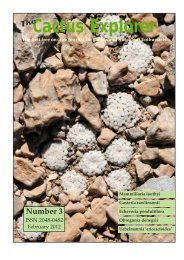Cactus Explorers Journal - The Cactus Explorers Club
Cactus Explorers Journal - The Cactus Explorers Club
Cactus Explorers Journal - The Cactus Explorers Club
You also want an ePaper? Increase the reach of your titles
YUMPU automatically turns print PDFs into web optimized ePapers that Google loves.
<strong>The</strong> <strong>Cactus</strong> Explorer ISSN 2048-0482 Number 4 May 2012<br />
first time in 2010 we saw the hill, and asked the<br />
people at the estancia if there were globular<br />
"pencas" there. <strong>The</strong>y confirmed and let us in.<br />
In the more open parts, there were only some<br />
Echinopsis albispinosa, then I moved to the other<br />
side of the hill, and there they were, just<br />
waiting for me! Really beautiful plants”.<br />
In terrain like this, the cacti are found only in<br />
places where they are not in competition with<br />
the leafy plants, for instance in rocky places,<br />
where their succulence is an advantage,<br />
allowing them to survive during the dry<br />
season. As you drive along the road, it can be<br />
36<br />
difficult to see places which might be suitable<br />
for cacti because in this region the hills are<br />
generally covered with a dense evergreen or<br />
semi-evergreen vegetation, so it can take much<br />
patient searching to find the plants.<br />
<strong>The</strong> name G. bayrianum first appeared<br />
(invalidly) back in 1967 but the plant is still not<br />
common in general collections. My seedlings<br />
first flowered when in 9cm pots and the plants<br />
get even more attractive when large. Its closest<br />
relatives are thought to be G. cardenasianum<br />
and G. spegazzinii.<br />
For the full story of G. bayrianum see my<br />
book: ‘Gymnocalycium in habitat and culture:<br />
p.132-133’ (2009) GC




